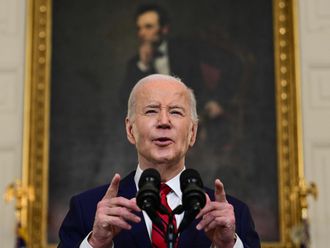
Orange, California: US Army Staff Sgt Horace Evers was setting up a command post in Munich with other Allied soldiers in the final days of the Second World War when he stumbled across sheets of Adolf Hitler’s personal stationery in the dictator’s abandoned apartment.
Evers, just barely 26, crossed out Hitler’s name below an embossed swastika, scrawled his own name and then sat down to write home about the stacks of hollow-eyed corpses he had seen the day before at Dachau.
“The first box car I came to had about 30 what were once humans in it,” he wrote in the May 2, 1945 letter. “All were just bone with a layer of skin over them. Most of the eyes were open and had an indescribable look about them.
“How can people do things like that? I never believed they could until now.”
The pages, now browned and creased, are part of a stunning collection of 90,000 wartime letters stretching from the Revolutionary War to modern-day conflicts in Iraq and Afghanistan that will be housed in a new Centre for American War Letters opening this autumn at Chapman University in Southern California.
Private collector and author Andrew Carroll, who began gathering war correspondence 15 years ago, began a nationwide speaking tour this week to unearth more historical gems gathering dust in the closets and attics of veterans and their descendants. A play based on the letters, ‘If All the Sky Were Paper’, will also tour this summer.
The war letters, some flecked with blood or coated with a fine layer of sand, bring history to life in a way that little else can. One from World War II is pierced by a bullet hole that hit the soldier’s backpack but did not kill him. Another is enhanced by an elaborate cartoon done by an airman who was supposed to work for Disney on his return but was killed in action.
“It’s about real people and what they go through, whether it’s frontline combat, whether it’s on the home front: Combat letters, love letters, last letters,” Carroll said. “The thing about war letters is, because they’re written in these life-and-death circumstances, almost by their nature they tend to be more vivid and vibrant. Everything is more intense.”
The collection, which Carroll dubbed the Legacy Project, covers the vast sweep of US history as seen through the eyes of the people who lived it.
One passionate letter was written by Spotswood Rice, a freed slave who joined the Union Army and realised his unit was passing within miles of his former master’s home, where his daughter Mary was still enslaved by the man’s wife.
“I want you to understand... that where ever you and I meets we are enmays to each orhtere,” wrote Rice, who was a private with the 67th US Colored Infantry, to the woman. “When I get ready to come after mary I will have... a power and authority to bring [her] away and to execute vengencens on them that holds my Child. You will then know how to talke to me.”
Another letter, raw with a different kind of emotion, is a last goodbye scrawled by a World War II POW on the back of two family photos he had carried with him throughout the war. Lt Thomas R Kennedy died shortly after he wrote the January 1945 note from aboard a Japanese prison ship.
“Momie & Dad: It is pretty hard to check out this way without a fighting chance but we can’t live forever. I’m not afraid to die, I just hate the thought of not seeing you again,” he wrote. “Take care of my nieces and nephews don’t let them ever want anything as I want even warmth or water now.”
Other letters provide a narrative of historical events in the unadorned language of scared young men.
One such account was penned by a seaman trapped aboard the USS New Orleans during the bombing of Pearl Harbour. The ship was undergoing repairs and had no power for its guns and no way of leaving port.
“We’re trying to get underway if possible,” Ensign William Czako wrote to his sister on December 7, 1941, as Japanese bombers screamed overhead. “We were just struck by a bomb near the bow.
“I don’t know why I am writing this because if we are hit with a bomb here — they won’t find enough of me and the rest — let alone this letter. I imagine it is to show myself that I can be calm under fire.”
Czako survived the war and went on to work in a Virginia shipyard.
The collection has just a few letters from the Revolutionary War, where paper was scarce and the postal service almost non-existent. In one extremely rare letter, however, a teenage soldier writes to his “honored parents” to say he was shot in the head but hopes that “with the Assistance of god that I Shall git wel again.”
The young private, Henry Johnson of New Jersey, survived and became a shoemaker, according to Carroll’s research.
Carroll, 43, got interested in collecting letters after his family home burned to the ground while he was in college. The fire destroyed his family’s letters and memorabilia and deeply affected Carroll, who became obsessed with ways to preserve connections to the past.
Sensing his need, a distant cousin who had fought in World War II gave him a war letter, saying he was considering throwing them away. In it, the cousin, then 23, wrote to his wife about the horrors of Buchenwald concentration camp just hours after touring it with his squadron.
“I was just shocked that he would just throw this away,” Carroll said. “There was real modesty with him and other veterans I spoke with who would say, ‘I was just a young guy. Who cares what I wrote?’ They were tossing their letters, too. I realised we were really losing something here.”
After another decade collecting a handful of letters from veterans through word of mouth and chance encounters, Carroll penned a plea for old wartime correspondence that was published in Dear Abby on Veteran’s Day 1998.
The response was immediate — and it was tremendous. Within a year, Carroll had received 15,000 letters — one couple alone sent 2,000 love letters they had exchanged during the Second World War.
“There were bins and bins of letters coming in and this was just the tip of the iceberg,” Carroll says.
In the years since, Carroll has continued to gather letters and, more recently, emails to and from soldiers serving in Iraq and Afghanistan. He has published four books of selected war letters from his collection and also took a 40-nation tour to collect correspondence written by foreign soldiers who have fought alongside — or even against — US troops.
Until now, Carroll used profits from the books to fund his ongoing efforts to preserve the war letters, which were kept in a storage unit near his Washington DC home. He also donated proceeds to veterans’ organisations but will now draw a salary as the director of Chapman’s new war centre.
Now that Carroll’s collection has found a permanent home, he is determined to expand it before it is too late.
Evers, the staff sergeant who wrote home on Hitler’s stationery, died in 2011 at the age of 92 and more veterans die every day, taking their memories with them. If their families do not know about their letters, they may be lost forever, he said.
“We have such a sense of urgency,” Carroll said. “A big part of our mission is to tell people, please, please go through what you have. You have no idea what might be hiding in your own personal archive.”












